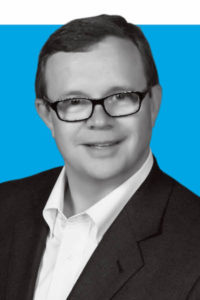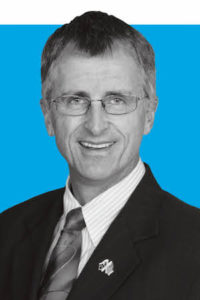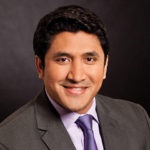Five winners of PCMA’s Education Foundation’s 2018 Professional Excellence Awards were announced May 2 at 2018 Visionary Awards at the Marriott Marquis, in Washington, D.C. Chosen from a field of 15 outstanding finalists, the Visionary Awards celebrate exceptional individual contributions to the business-events industry.
Convene has the backstory on two of the award winners — Jeff Chase, vice president of sustainability, Freeman Company, named Community Advocate of the Year; and Phelps R. Hope, CMP, senior vice president, meetings and expositions, Kellen Company, named Event Designer of the Year. Congratulations to all of the finalists and award winners.
Community Advocate of the Year
Jeff Chase, Vice President of Sustainability, Freeman Company

Few things say “excess” like a tractor-trailer load of waste leaving a convention. And few things give Jeff Chase greater satisfaction than seeing those trucks — filled with food, furniture, stationery, flooring, you name it — headed to local organizations that can put them to good use.
“Most shows send 40, 50 percent of their waste to landfills. But if you do the advance planning and proper thinking, you can donate a lot to the community, put things in the right recycling bin and do the right thing,” Chase said.
At the monolithic CES (Consumer Electronics Show) in Las Vegas, where “the volume of waste is huge, the biggest waste show we have,” Chase works to make waste into a more manageable 75 percent reclaimed materials. And with Greenbuild International, a show dedicated to sustainability in the construction industry, that figure soars to 90 percent.
Chase has been head of sustainability for Freeman since 2011, when the global events company bought Chase’s planning firm, including its portfolio of green-focused clients. In those seven years, Chase has seen the demand for green operations soar. “In the beginning, it was hard to identify really how many environmentally focused clients Freeman had,” he said. “Many people do want to do the right thing, but after putting so much effort into planning a show, don’t want to put the time into the end of the show — what will happen with all the things used. But a little time makes a huge impact.” Chase estimates that green-minded clients now represent $400 million of Freeman’s business.
Some of the things he’s helped repurpose: Tools, tile, hardwoods, carpeting, countertops, and flooring used in exhibits at a hardware show were diverted to industry interns and building organizations like Habitat for Humanity. Truckloads of unopened, small packages of food from displays at a convenience store association convention were sent to multiple locations of Ronald McDonald houses. Playthings from a massive toy fair that needed to be unboxed and constructed for display — but don’t lend themselves to going back into boxes — hello, Toys for Tots.
“Whatever your show is about, whether it’s medical or fancy food, you’ve brought all these things: tables and chairs for booths, carpeting and décor to make the booth special,” Chase said. “And in so many cases it’s just thrown away.”
Event Designer of the Year
Phelps R. Hope, CMP Senior Vice President, Meetings and Expositions, Kellen Company

If the Girl Scouts of the USA had a badge for Convention Reinvention, Phelps R. Hope, CMP, would have earned it — by overseeing the overhaul of the the 105-year-old institution’s national triennial event.
Held in October 2017 at the Greater Columbus Convention Center, the Girl Scouts of the USA (GSUSA) national convention pulled off a number of firsts for the organization.
The new event — orchestrated by Hope, senior vice president, meetings and expositions, for association-management firm Kellen Company — was several years in the making, and part of GSUSA’s strategy to “retool how they position themselves,” Hope said, “with members of the future.” Like many traditional associations GSUSA was struggling to remain relevant to younger, tech-savvy audiences. “Young girls today don’t need to join a troop and put on a uniform and earn badges to get a sense of self-worth,” Hope said. “They’re connecting with friends online and getting those needs met through the world of social media.”
Among other things, Phelps led the organization in taking what had been a five-day event and turning it into two events, including a new, open-to-all-girl events called G.I.R.L., an acronym for Go-getter, Innovator, Risk-taker, and Leader.
Splitting the event in two made a lot of sense on paper, but “this is where it really logistically became an incredible exercise,” Hope said. The Girl Scout convention had historically attracted 5,000 attendees, and nearly double that was planned for the G.I.R.L. event.
For a full report on how Phelps managed to pull that off, while upgrading the gathering’s production values for a new generation and creating an interactive exhibit hall, see the story “Not Your Mother’s Girl Scout Convention.”



